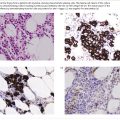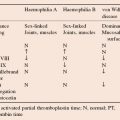Heparin
Heparin is a mucopolysaccharide that is not absorbed when given orally and is therefore given subcutaneously or intravenously. It activates antithrombin which irreversibly inactivates prothrombin, Xa, IXa and XIa. It also impairs platelet function. Unfractionated heparin (UFH) is a heterogeneous mixture of polysaccharide chains. Low molecular weight (LMW) heparin preparations (MW <5000), e.g. enoxaparin (Clexane), deltaparin (Fragmin) and tinzaparin (Innohep) have a greater ability to inactivate factor Xa and less effect on thrombin (Fig. 45.1) and platelet function, and therefore have a lesser tendency to cause bleeding. They have a longer plasma half-life so that once daily subcutaneous administration is effective in prophylaxis. They also interact less than UFH with endothelium, plasma proteins, macrophages and platelets, making their action more predictable and eliminating the need for monitoring except in certain individuals (see below).
Indications
- Acute venous thrombosis, e.g. deep vein thrombosis (DVT) and pulmonary embolism. Subcutaneous LMW heparin at a therapeutic dose is now usually used. Continuous intravenous UFH can also be given. Warfarin is usually started 2 days after heparin. Heparin can usually be discontinued when international normalized ratio (INR) (see below) is >2.0.
- Unstable angina, post-myocardial infarction.
- Disseminated intravascular coagulation if this is dominated by thrombosis.
- Acute peripheral arterial occlusion.
- Prophylaxis of DVT in surgical and other hospital patients at risk of DVT (LMW heparin once daily).
- Thrombosis prophylaxis in patients undergoing cardiac surgery or renal dialysis.
- Pregnancy. As warfarin is teratogenic, LMW heparin is used in pregnancy when anticoagulation is needed.
- Recurrent fetal loss.
- Maintaining patency of indwelling lines, e.g. Hickman and of catheters.
Monitoring
For continuous intravenous infusion, the activated partial thromboplastin time (APTT) should be maintained at 1.5–2 times normal. LMW heparin therapy is not normally monitored; if necessary, e.g. in renal failure or in those of very low (<50 kg) or high (>80 kg) body weight, it can be monitored by factor Xa assay.
Side effects
- Haemorrhage, particularly if combined with antiplatelet therapy, overdosage or, rarely, platelet function defect. Heparin has a short half-life (1 h); levels fall rapidly when infusion stopped. Protamine sulfate will reverse heparin immediately but must be used with caution as it can cause haemorrhage at high dosage.
- Long-term therapy (>2 months) can lead to osteoporosis.
- Thrombocytopenia, which is antibody mediated. Platelet clumping may cause arterial thrombosis (see Chapter 44

Stay updated, free articles. Join our Telegram channel

Full access? Get Clinical Tree





